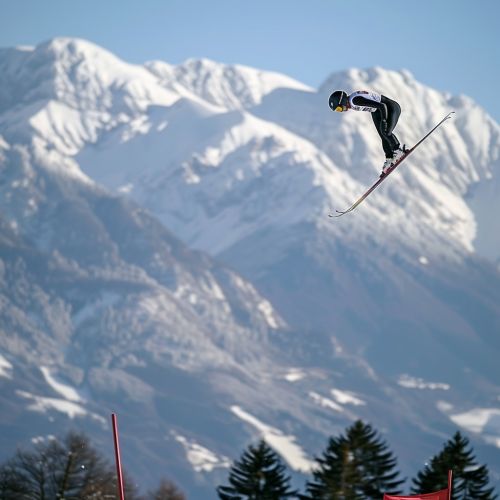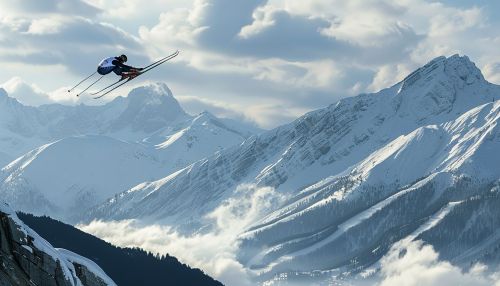Planica
History and Development
Planica is a valley in northwestern Slovenia, located in the Julian Alps, near the town of Kranjska Gora. It is renowned for its ski jumping and flying facilities, which have played a significant role in the history of winter sports. The valley has been a focal point for ski jumping since the early 20th century and has hosted numerous international competitions.
The development of Planica as a ski jumping hub began in the 1930s. The first ski jump, known as the Bloudkova velikanka, was constructed in 1934 by Stanko Bloudek, a Slovenian engineer and sports enthusiast. This jump was revolutionary at the time, allowing jumpers to reach distances previously thought impossible. In 1936, Sepp Bradl of Austria became the first person to jump over 100 meters, marking a significant milestone in the sport.
Over the years, Planica has seen numerous upgrades and expansions. The construction of the Letalnica bratov Gorišek, or Gorišek Brothers' Flying Hill, in 1969, further cemented Planica's status as a premier location for ski flying. This hill has been the site of many world records, including the first jump over 200 meters by Toni Nieminen in 1994.
Ski Jumping and Ski Flying
Planica is synonymous with ski jumping and ski flying, two disciplines that test the limits of human ability and engineering. Ski jumping involves athletes descending a ramp and launching themselves into the air, aiming for maximum distance and style points. Ski flying, a more extreme version, takes place on larger hills and allows for even greater distances.
The Letalnica bratov Gorišek is one of the largest ski flying hills in the world. It has a K-point of 200 meters and a hill size of 240 meters, making it a formidable challenge for even the most skilled athletes. The hill has undergone several renovations to ensure safety and maintain its status as a world-class facility.
Planica has hosted numerous World Cup events, World Championships, and other international competitions. The annual FIS Ski Flying World Championships are a highlight of the winter sports calendar, attracting top athletes from around the globe. The valley's unique geography and favorable wind conditions make it an ideal location for these events.


Technological Innovations
Planica has been at the forefront of technological advancements in ski jumping and ski flying. The construction of the Bloudkova velikanka and Letalnica bratov Gorišek were engineering marvels of their time, pushing the boundaries of what was thought possible. These hills have been continually updated with modern materials and techniques to ensure safety and performance.
One significant innovation is the use of artificial snow and refrigeration systems. These technologies allow for consistent and reliable conditions, essential for fair competition. The hills are equipped with state-of-the-art wind nets and barriers to minimize the impact of wind, a critical factor in ski jumping and flying.
The introduction of video distance measurement and electronic scoring systems has also revolutionized the sport. These systems provide accurate and immediate feedback, enhancing the spectator experience and ensuring precise results. Planica's facilities are equipped with the latest in sports technology, making it a model for other venues worldwide.
Environmental and Economic Impact
The development of Planica has had a significant impact on the local environment and economy. The valley's transformation into a world-class sports venue has brought increased tourism and investment to the region. The annual ski jumping and flying events attract thousands of visitors, providing a boost to local businesses and infrastructure.
However, the environmental impact of these developments cannot be overlooked. The construction and maintenance of the ski jumps and associated facilities have altered the natural landscape. Efforts have been made to mitigate these effects, including reforestation projects and the use of environmentally friendly materials and practices.
The economic benefits of Planica extend beyond tourism. The valley has become a center for sports science and research, attracting experts and professionals from around the world. The facilities are used for training and development, contributing to the advancement of winter sports.
Cultural Significance
Planica holds a special place in Slovenian culture and history. It is a symbol of national pride and achievement, representing the country's contributions to winter sports. The annual ski jumping and flying events are major cultural events, drawing large crowds and media attention.
The valley has also inspired numerous works of art, literature, and music. It is a source of inspiration for many Slovenian artists and writers, who celebrate its beauty and significance. Planica's legacy is preserved in museums and exhibitions, ensuring that future generations can appreciate its history and impact.
Future Developments
Looking ahead, Planica continues to evolve and innovate. Plans are in place for further upgrades to the facilities, including the construction of new training centers and accommodation for athletes. These developments aim to maintain Planica's status as a premier destination for ski jumping and flying.
Sustainability is a key focus for future projects. Efforts are being made to reduce the environmental impact of the facilities and events, including the use of renewable energy sources and sustainable materials. The goal is to balance the needs of the sport with the preservation of the natural environment.
Planica's future is bright, with continued investment and innovation ensuring its place at the forefront of winter sports. The valley's rich history and cultural significance will continue to inspire and attract visitors from around the world.
